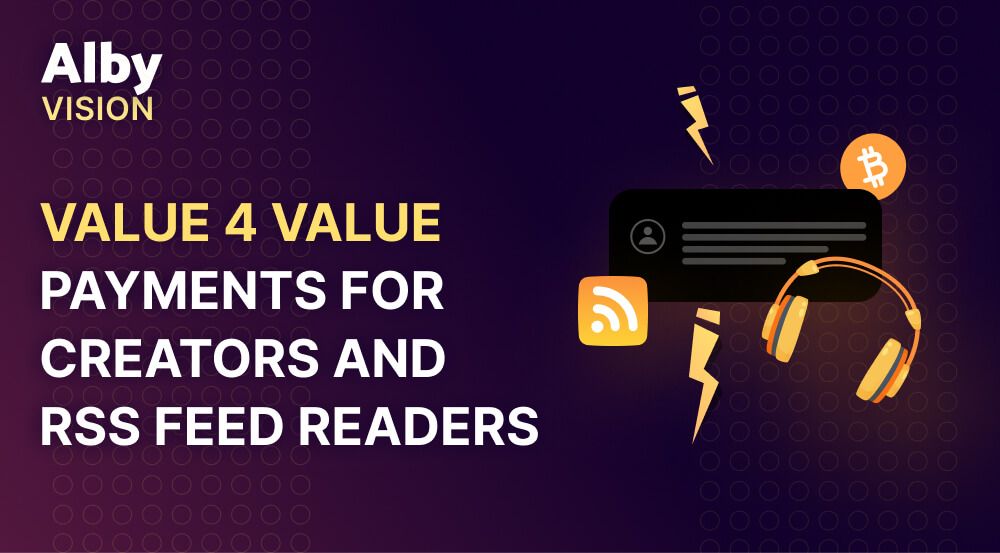Value4Value payments for creators and RSS feed reader apps

The building blocks are in place to facilitate meaningful connections and direct payments between creators and consumers.
RSS - a smart way to distribute content
With so much new content on the web added daily, it can be tough to keep up with what’s happening online. To stay informed people try several different ways, including visiting specific websites, doing Google searches, or relying on social media every day. But there is an incredibly smart solution to that: The RSS feed, short for “straightforward syndication” or “rich site summary”. Equally straig
htforward is its usage for content creators, apps, and consumers, because it is a standardized and human-readable format. That’s what makes RSS an incredibly smart way to distribute content.
Is RSS still a thing?
Yes, but RSS lost its popularity. Social media sites like Twitter or Facebook, and others have become the go-to option for following publishers and learning about the latest content. That reverses the actual intention of RSS facilitating a direct content distribution between the creator and the consumer. This direct relationship breaks up when publishers make themself dependent on these platforms as a distribution channel for their content. Are a few dollars of advertisement revenue worth it?
Meanwhile, an impressive 43% of websites utilize WordPress as their preferred content management system. Interestingly, nearly all WordPress blogs still offer an RSS feed, accessible by simply adding "/feed" to the URL. Despite its diminished visibility, RSS has remained a viable technology. The question then arises: how can we revive its popularity?
The success of Podcasting 2.0
Podcasting is striving compared to other content formats relying on RSS. One reason is the Podcasting 2.0 initiative which aims to improve the experience of both creators and their listeners. This new and open standard improves the listening experience through transcripts, chapters and many, many more features. In addition, the initiatives standardized a way for direct content monetization between consumers and publishers, an incredibly important innovation for a sustainable creator economy. But more importantly, Podcasting 2.0 is gaining popularity and adoption.
“Value for Value” payments
A new method of compensating creators made feasible by Podcasting 2.0 and bitcoin as an open payment network is known as "Value for Value" (V4V). However, the underlying idea is not brand-new. For instance, when a hat is handed around after a public performance of music, the audience members contribute what they believe to be a fair value for the performance, and the artist receives the money directly, with no middleman receiving a commission.
Since it was introduced, dozens of apps have included the capability, and thousands of podcasters now get compensation from their listeners on a minute-by-minute basis.
Benefits for creators, consumers and apps
The key distinction between a conventional transaction and a V4V (Value-for-Value) transaction lies in the voluntary, unrestricted, and direct nature of the latter. This makes V4V a risk-free method for creators to receive fair compensation for their work, without excluding consumers who may not be willing to pay a predetermined price. Moreover, V4V fosters a more direct relationship between creators and consumers, as consumers can send comments along with payments, encouraging a loop of co-creation and community building across various apps. Notably, this advantage is independent of any closed social media platform.
Obviously, feed reader apps can harness these payment flows and novel forms of interactions between creators and consumers, resulting in various benefits such as additional revenue streams and heightened user engagement. Each payment conducted within the app presents an opportunity for the app to add a slight markup. Depending on how it is implemented, consumers may also have the ability to attach messages along with their payments - a highly engaging feature for users.
Replicate the success
The building blocks are in place to replicate the success of podcasting in other content formats. This includes creators publishing articles through RSS, feed reader apps delivering the content to consumers, a growing adoption of the RSS-based standard for direct payments, a global and open payment network, and user-friendly publisher and consumer wallets. The question now is: how can we connect these elements together to create a flourishing ecosystem?
One option is to create a new namespace or expand the existing one. However, an alternative approach could be to leverage the RSS namespace extension for podcasting, which already includes the necessary tags. For instance, the value tag can be used to define the payment method and recipient, while the new medium tag allows for easy differentiation of content types, such as "blogpost", "newsletter", "video", or "music", as specified values. This approach streamlines the implementation process, utilizing existing infrastructure and established standards.
This is a showcase of Feedbin with an integrated payment functionality for RSS feeds.
Direct content distribution linked to direct monetization
Value4Value is a monetization model that is about freedom and openness and connection. Podcasting 2.0 has emerged as the largest success in applying the V4V model to date utilizing RSS as its foundation.
To use the words of Sara Watson: “The glory days of blogging may be making a comeback, if writers are landing on a viable monetization strategy beyond exploiting user data or ads.” V4V is a viable and risk-free way of creating another income stream. But it can also be a first step to monetizing premium content directly and independently of existing closed media platforms.
Are you a content publisher or developer of a feed reader app and want to dive into V4V? Reach out, and let’s work together on the future of open content distribution.